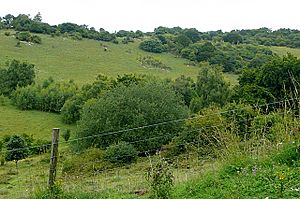Watlington and Pyrton Hills facts for kids
| Site of Special Scientific Interest | |
 |
|
| Area of Search | Oxfordshire |
|---|---|
| Interest | Biological |
| Area | 112.7 hectares (278 acres) |
| Notification | 1989 |
| Location map | Magic Map |
Watlington and Pyrton Hills is a really special natural area in Oxfordshire, England. It covers about 112.7 hectares, which is a huge space full of interesting plants and wildlife. This area is located just east of the town of Watlington.
A small part of this area, about 1.6 hectares, is called Watlington Chalk Pit. This specific spot is also known as a Local Nature Reserve, which means it's a place where nature is protected and people can visit to learn about it.
Discover Watlington and Pyrton Hills
This beautiful site is known for its many different types of habitats. You can find chalk grassland, which is a special kind of grassy area growing on chalky soil. There are also chalk scrub areas, which are like bushy patches, and broadleaved woodlands with lots of different trees. You might even spot areas with many yew trees.
What Makes This Place Special?
Watlington and Pyrton Hills is officially a "Site of Special Scientific Interest" (SSSI). This means it's a protected area because it has important plants, animals, or geological features. The government recognizes these places as vital for nature.
Amazing Plants and Habitats
The chalk grassland at Watlington Hill is quite unique. It has short grass because rabbits often graze there, keeping it trimmed. This short grass allows many beautiful flowering plants to grow and thrive.
Some of the cool plants you might see here include:
- Yellow-wort: A plant with bright yellow flowers.
- Dropwort: Known for its creamy-white flowers that grow in clusters.
- Horseshoe vetch: A yellow-flowered plant that is important for certain butterflies.
- Squinancywort: A small plant with tiny pink or white flowers.
- Candytuft: This plant is very rare in the UK and has white or purple flowers. Finding it here makes the site even more special!
The mix of these different habitats – grasslands, scrub, and woodlands – makes Watlington and Pyrton Hills a fantastic home for many different species of plants and animals. It's a great example of how different parts of nature work together.

